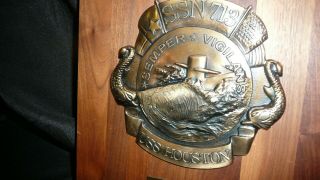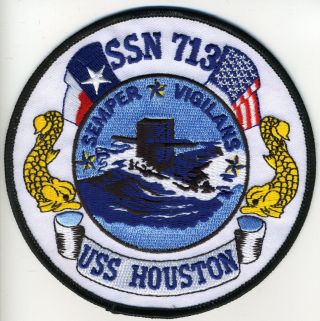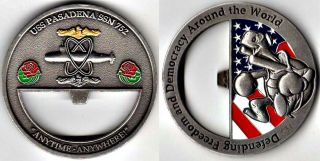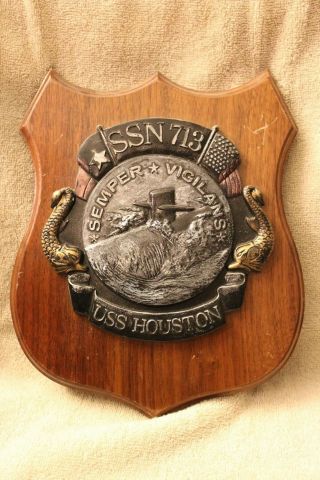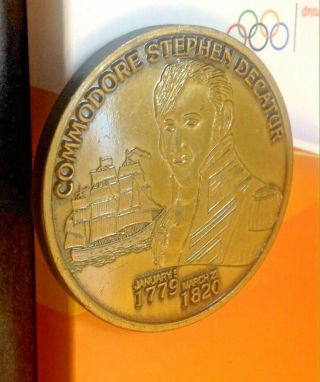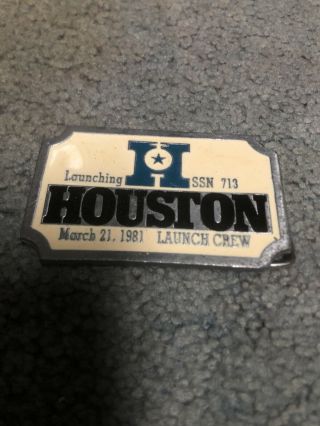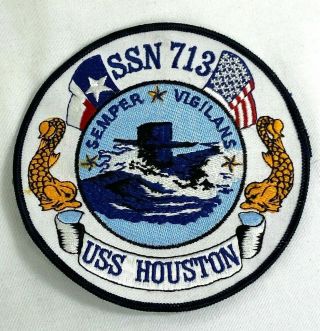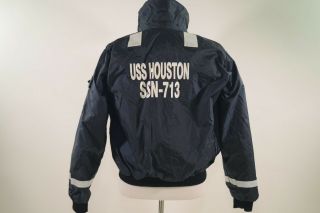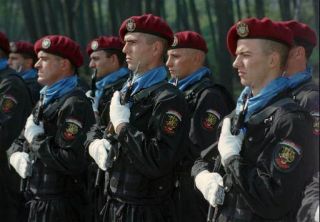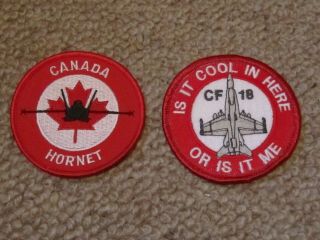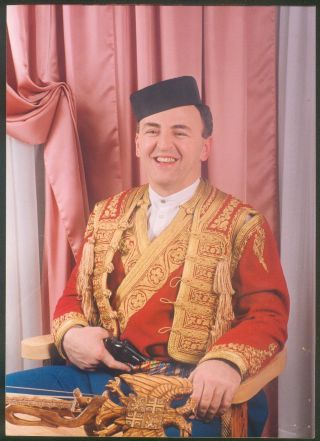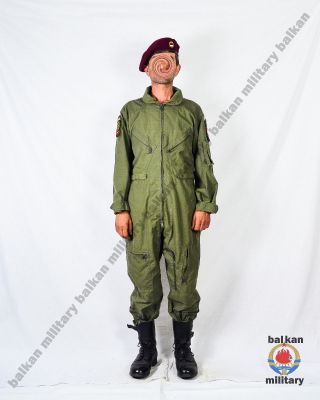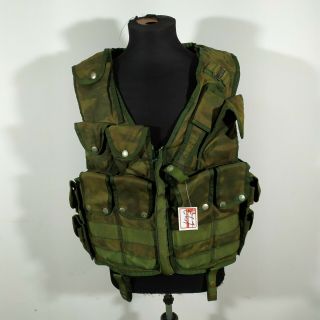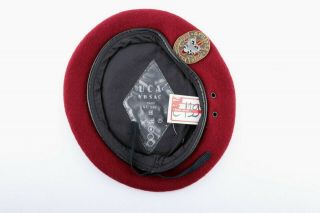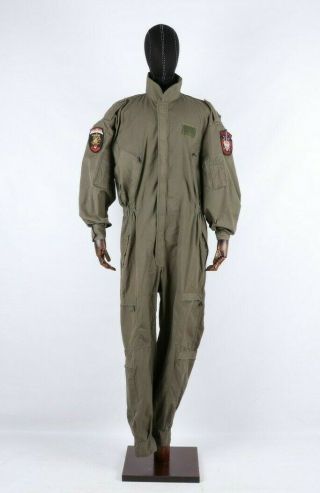CHALLENGE COIN USS HOUSTON SSN - 713 USN NUCLEAR - POWERED SUBMARINE_FAST ATTAC
Item History & Price
| Reference Number: Avaluer:68842 |
CHALLENGE COIN USS HOUSTON SSN-713*MINT* USN NUCLEAR-POWERED SUBMARINE_FAST ATTACK LOS ANGELES CLASSI RECEIVED THIS ONBOARD THE SHIP AROUND 2000 AND IT HASSAT IN MY DESK DRAWER EVER SINCE. NEVERBEEN OUT OF THE BOX; NEVER HAD FLUID PUT IN IT; NEVER BEEN STRUCK. MARITIME KEEPSAKE. PERFECT GIFT FOR CURRENT / FORMER CREWMEMB...EROR PERSON INTERESTED IN THE EUNITED STATES NAVY.If your Dad orBrother or Son (women were not yet allowed to serve in submarines during thetime this ship was in commission) was a former crewmember perhaps he mis-placedhis during one of many moves and now you can replace it. Collectors ofCold War Militaria value these (especially from nuclear-powered submarines) andthey are especially difficult to find since the crews were small (hence, fewwere made) and by the nature of their propulsion system & un-publicizedoperations they made very infrequent port visits. ---------------------------------------------------------------------------------------------- AdditionalInformation from Internet Encyclopedia USS Houston(SSN-713), a Los Angeles-class attack submarine, was the fourth ship of theUnited States Navy to be named for Houston, Texas. The contract to build herwas awarded to Newport News Shipbuilding and Dry Dock Company in Newport News, Virginia on 1 August 1975 and her keel was laid down on 29 January 1979. Shewas launched on 21 March 1981 sponsored by Barbara Bush, wife of thenVice-President of the United States George H. W. Bush. Houston was commissionedon 25 September 1982, with Captain G. H. Mensch in command. Curiously, her hullnumber matches the area code for the interior portion (inside the Beltway/SamHouston Tollway, as of 2000) of Metropolitan Houston, which is also 713, but atthe time she was built 713 encompassed most of Metro Houston within HarrisCounty.Houston is an experienced actor, initiallystarring in a Navy recruiting film and then getting her "big break"in June 1989 with a part in The Hunt for Red October (where she played hersister ship Dallas). However, that summer and autumn were plagued with mishaps.In May 1989, before getting involved with thefilm, a broken valve caused a depth excursion. However, the "depthexcursion" was actually a full blown flooding incident that was not causedby a "broken valve". In fact, while conducting a weaponscertification inspection prior to a scheduled westpac, the Officer of the Deck(OOD), directed the Chief of the Watch (COW) to silence the induction sump tankalarm due to constant cycling. The OOD then directed the COW to pin open thediesel head valve in order to stop the constant cycling of the pneumaticactuator (due to state 3 seas). Upon securing the antennas (the boat wasventilating while near the surface to pick up routing radio traffic), the OODdirected the boat to return to its regular patrol depth. However, because noFan Room watch was set when the alarm was cut-out, nobody immediately noticedthat water was dumping into the Fan Room when the boat started to dive. Itwasn't until there was an announcement of flooding in the Torpedo Room over the4MC that the crew went to General Quarters. At this time, the Throttlemananswered ahead-full and the OOD ordered a five-second emergency blow of theforward ballast tanks. Of course, when the boat went to a positive bubble, allthe water in the ventilation system dumped into the engine room. Afterbroaching the surface, the boat went nose down again (still at ahead full), andbegan a second downward descent. The CO finally ordered a full emergency blowto get Houston back to the surface. Then on 14 June, during the shoot, Houstonsnagged a tow cable, sinking the tugboat Barcona in the San Pedro Channel nearSanta Catalina Island, and drowning a tugboat crewmember. While sonar was awarethe tugboat was in the area (designated as Sierra 22) it was on a course thatwas well west of the boat. Then, two days later, after filming wrapped, Houston was en route to San Diego, California when she was caught in the net ofthe fishing boat Fortuna. The nets were destroyed, but no injuries werereported. On 1 July 1989, Houston left port for a trainingrun. A few days into the training schedule, a standard low-pressure ventilationprocedure was conducted at periscope depth. Suddenly and unexpectedly, seawaterbegan flooding from the main air vents. The boat took a sharp up-angle andbegan driving toward the surface, but lost headway to the weight of the watershe had taken on and began to slide backward. Seawater reached the batterycompartment and chlorine began to rise from the battery well. The full power of the Houston’s engines restoredheadway and drove her to the surface. As soon as she broached, however, shelost her up-angle, and the thousands of pounds of water in her bilges rushedforward. The boat pitched forward, taking on a steep down-angle. Pulled by theweight of the water and pushed by the full power of her engines, Houston doveprecipitously. The engines were reversed in a crash-backmaneuver and an emergency ballast tank blow was performed. Houston’s plungeslowed, reversed, and she shot up again, this time remaining on the surface. Houston returned to port after a long and slowsurface transit. The main snorkel valve had failed to close properly. Anaudible signal that would indicate the valve's opening and closing had beendisabled. While eight crewmen were transferred from the Houston, not all leftthe submarine service. Houston's troubles were not over. On 1 August, an electrical fire ignited in the engineering spaces. In September, because ofa navigation error, the boat had a close call with a torpedo launched from ahelicopter in a training exercise. In November, a navigation error caused theloss of the boat's towed sonar array. Crewmen aboard the boat during her troubles inthe late 1980s/early 1990s called her the boat from hell; some with affection, some not. Following a Depot Modernization Period in 1991, Houston experienced a few incidents related to the relative inexperience of hernew crew. One of these incidents occurred during her first underway followingthe DMP. While on the surface proceeding out of Pearl Harbor, the OOD, who wasin the sail, failed to compensate for the Captain ordering a higher speed thanpreviously briefed. Because of this, the OOD ordered a turn later than heshould have and the boat came within 100 yards of striking the remains of anold concrete pier. Shortly thereafter, out of the channel and in into openocean, the same OOD ordered ahead full while the forward escape trunk was stillopen. Those who know 688 class submarines know that water washes over the deckaft of the sail when the ship is at ahead full. The error was realized when thefirst call of "flooding in crews mess" was made over the 1 MC. After several months of preparation and movementto San Diego, CA, the ship embarked on an incident free deployment to thewestern Pacific (WEST PAC). With stops in Thailand, Japan, Okinawa and Darwin, Australia, the Houston started to shed her hard luck image. Upon returning to San Diego in May 1993, shespent a year in upkeep and training preparing for her next deployment. With anew coat of paint (from a 3-month dry dock stay in the Fall of 1993) Houstondeployed again to the West Pac in the Spring of 1994. This deployment was quickly marred by mechanicaldifficulties when the ship's aft stern tube bearing failed 6 weeks into thedeployment. The Herculean repair involved an in water screw removal and the useof a floating crane towed in from Pearl Harbor Naval Shipyard. For nine weeks Houston was stuck in port while aspecial team from Pearl Harbor repaired the stern tube bearing. With her screwreplaced, Houston returned to her sea duties in late August 1994. The shipreturned home to San Diego in time for her crew to enjoy the 1994 holidayseason. In December 1998, Houston was off the coast ofsouthern California during a training exercise when the common discharge flexcoupling for the boat's R-12 units ruptured. R-12 is a refrigerant that is usedin air-conditioning and refrigeration units. The quick actions of the crewallowed the R-12 to be ventilated overboard while the crew were in emergencyair-breathing apparatus (EABs) that protected them from the asphyxiatingeffects of the gas. A quick stores off-load also saved the perishable foods inthe refrigeration compartments. A subsequent and similar rupture happened againin late 1999. These flex-coupling weaknesses have been identified as classproblems on the Los Angeles class. Houston was awarded the Battle "E" andengineering "E" in 1998 and Tactical "T"'s in 1999 and2000. In May 2000 Houston while transiting betweenPearl Harbor, and Yokosuka, Japan, damaged her screw, and had to return toPearl Harbor for repairs. USS Asheville took over Houston's duties, andcompleted her planned mission. In September 2000 Houston lost her anchor whileattempting to anchor off the coast of Pattaya Beach, Thailand for a port call.In order for the crew to get a few days of much needed liberty, the crew wasdivided and took turns steaming the ship around the bay while theircounterparts were ashore. On 21 June 2001 Houston was conducting normaltraining operations in the Pacific off the coast of Washington state, whichincluded a "crash back" drill, in which the ship goes from aheadflank (maximum forward speed) to back full emergency (maximum engine power inreverse). The maneuver proceeded well, despite the tremendous shaking, noise, and stress the maneuver creates, until the boat began to gain sternway(actually moving backwards through the water). When a vessel is moving backwards, her rudderand in the case of a submarine, her planes, function in the opposite mannerthan when she is moving forwards. The stern planesman failed to compensate forthis phenomenon and continued to try to trim the boat as if they still weremaking headway. When the stern began to rise, he raised the stern planes, whichwould have depressed the stern if they had been moving forward. While makingsternway, it had the opposite effect, increasing the down-angle. The sterncontinued to rise, more rapidly as the boat accelerated backwards. Before theproblem could be corrected, Houston had attained a 70 degree down-angle and herscrew broached the surface while still turning at a high rpm. The control teamperformed a partial emergency ballast tank blow and safely surfaced the boat, and the engineering team safely scrammed (emergency shutdown) the reactor plantto prevent damage. Houston underwent an extensive overhaul at PugetSound Naval Shipyard in Bremerton, WA, commencing September 2001. The upgradesincluded a reactor refueling and instrumentation upgrade, as well asnavigation, fire control and sonar upgrades. In December 2004, Houston departedPSNS for her new homeport of Apra Harbor, Guam. Author RobertD. Kaplan embedded aboard the ship in the spring of 2005 and recounted hisexperiences in her for his book Hog Pilots, Blue Water Grunts in Chapter Four"Geeks with Tattoos: The Most Driven Men I have Ever Known." On 1 August2008 the Navy reported to CNN that Houston was found to have been leakingradioactive water for months while on patrol and visiting stations in Japan, Guam and Hawaii. The problem was discovered the previous month during servicingat Pearl Harbor. One crewman was exposed to radioactive water but not injured.The Navy reported that the Houston's leak released only a"negligible" amount of radioactivity. The Navy later expanded theestimated time the leak existed to nearly two years, although they maintainedthe amount of radioactivity leaked was very small – "less than a smokedetector". On 28 October 2015, Houston moored in Pearl Harbor, after completing her final scheduleddeployment. She was decommissioned on 26 August 2016 in a ceremony at NavalBase Kitsap—Bangor. Houston wasawarded the Battle "E", Engineering "E", Navigation"N", and Communications "C" in 1998 and Tactical"T"'s in 1999 and 2000. In 2006 Houston earned the Battle"E", Engineering red "E", Medical yellow "M" andSupply blue "E" for operational excellence from her squadron CSS-15.Houston repeated as the CSS-15 Battle "E" boat in 2007. Houstonearned two Navy Unit Commendations and two Meritorious Unit Commendations.
PaymentBack to Top
I accept the following forms of payment: PayPal
Shipping & HandlingBack to Top US ShippingPlease check eBay's Shipping & Payment tab
USPS Priority Mail®
International ShippingPlease check eBay's Shipping & Payment tab
USPS First-Class Mail International (Worldwide)
FREE scheduling, supersized images
and templates. Get Vendio Sales Manager.Make your listings stand out with
FREE Vendio custom templates!
FREE scheduling, supersized images
and templates. Get Vendio Sales Manager.
Over 100, 000, 000 served. Get FREE counters from Vendio today!




